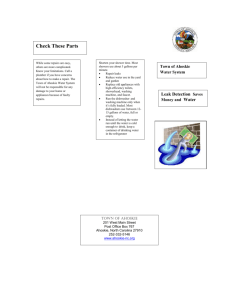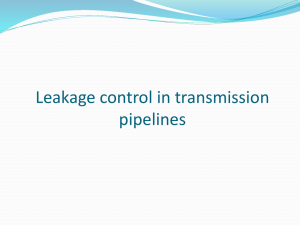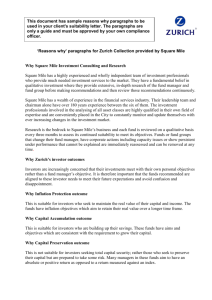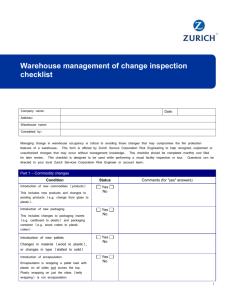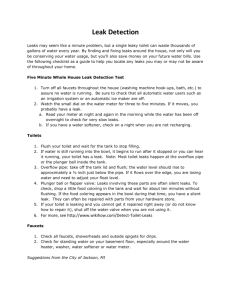checklist here
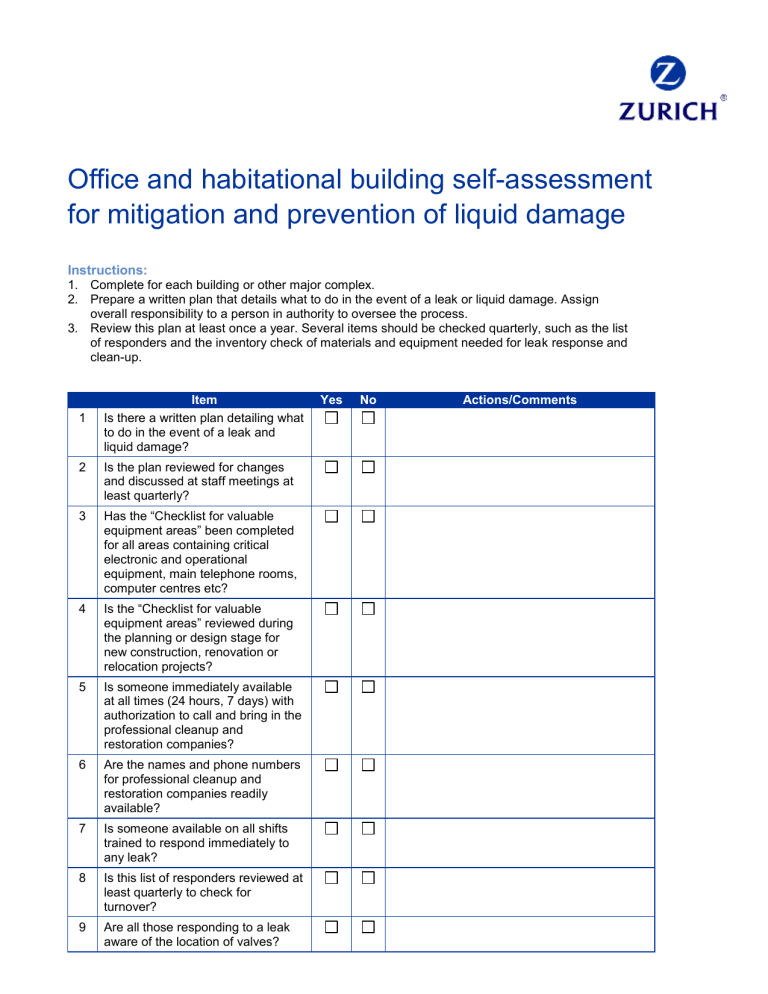
Office and habitational building self-assessment for mitigation and prevention of liquid damage
Instructions:
1. Complete for each building or other major complex.
2. Prepare a written plan that details what to do in the event of a leak or liquid damage. Assign overall responsibility to a person in authority to oversee the process.
3. Review this plan at least once a year. Several items should be checked quarterly, such as the list of responders and the inventory check of materials and equipment needed for leak response and clean-up.
Actions/Comments Item
1 Is there a written plan detailing what to do in the event of a leak and liquid damage?
2 Is the plan reviewed for changes and discussed at staff meetings at least quarterly?
3 Has the “Checklist for valuable equipment areas” been completed for all areas containing critical electronic and operational equipment, main telephone rooms, computer centres etc?
4 Is the “Checklist for valuable equipment areas” reviewed during the planning or design stage for new construction, renovation or relocation projects?
5 Is someone immediately available at all times (24 hours, 7 days) with authorization to call and bring in the professional cleanup and restoration companies?
6 Are the names and phone numbers for professional cleanup and restoration companies readily available?
7 Is someone available on all shifts trained to respond immediately to any leak?
8 Is this list of responders reviewed at least quarterly to check for turnover?
9 Are all those responding to a leak aware of the location of valves?
Yes No
Item
10 Does the staff have immediate access to a spill response cart/supplies and emergency pipe repair supplies?
11 Is the supply of spill response and pipe repair materials complete, readily accessible and checked at least quarterly?
12 Are pipe diagrams or prints up-todate and showing the location of valves for all liquid-carrying systems? Isometric drawings are very beneficial. (Note 1)
13 Are valves placarded or tagged for easy identification?
14 Are shutoff valves “exercised”
(closed, reopened and lubricated as needed) at least annually to verify they can be quickly closed during an emergency?
15 Are small leaks promptly repaired?
A small leak may be a sign of hidden corrosion or other problem with potential for growing into a catastrophic leak.
16 Is the cause of any leak analyzed to determine if it was an isolated occurrence or a symptom of a system-wide problem?
17 Are housekeeping personnel instructed to immediately notify maintenance when any types of dripping, leakage or clogged drains are found?
18 Is there a lockout/tagout procedure in place when valves are shut on liquid-carrying systems under repair or modification?
19 Is there close monitoring of thirdparty work that may affect piping systems (sprinklers, water, etc.)?
20 Are there any liquid storage tanks or vessels (hot water, condensate, boilers, fuel oil, etc.) inside the building, mechanical penthouse or on the roof?
21 If so, is there a dike around the tank or vessel and/or drains to contain or effectively carry away leaking fluids? Dikes are required around fuel tanks.
Yes No Actions/Comments
Item
22 Are there leak detection sensors at low points and inside diked areas?
If so, have these been tested regularly?
23 Are there any floor openings or cracks through which a leaking fluid may pass through and damage areas below? (Note 2)
24 For basement areas, are there any water mains, sprinkler mains or liquid utility piping entering through the walls or floor?
25 Is there any evidence of leakage or seepage through the wall or floor openings? If so, indicate repair schedule.
26 Is an underground plan of these mains immediately available showing the location of shutoff valves? (in case an underground leak occurs and water flows through the wall or floor opening) (Note 3)
27 If any part of the property is exposed to potential flood, is there a formal flood emergency plan or similar flood preparation plan?
28 If your office is in an earthquake- prone area, has your automatic sprinkler system been surveyed by a professional to determine extent of vulnerability for leakage? (Note
4)
29 Are roofs inspected regularly
(minimum of every 6 months, or after severe storms) to check for damage or deterioration such as cracking, splitting, blistering, separation, holes or other potential sources of leakage?
30 Are there any roof leaks or evidence of ponding on the roof? If so, indicate reasons and the repair schedule.
31 Are roof-mounted cooling towers inspected regularly, and are cooling tower basins “watertight”? (Note 2)
32 Are there any areas directly adjacent to the building where rainwater can accumulate during heavy rains? Large landscaping planters built next to grade wall and windows are an example where water can pond and find its way into the building.
Yes No Actions/Comments
Notes:
1. Liquid-carrying systems may include: sprinkler systems, hot and cold water piping, chilled water lines for cooling, hot water lines for heating, condensate piping, sewer lines, drain lines, fuel oil piping, etc.
2. Floor openings often occur around penetrations made for pipe and conduit. Seal the open space around the pipe or conduit to prevent passage of liquid. Often, these are penetrations in concrete floors that are required to be fire stopped anyway. Use a fire stop that produces a tight liquid seal as well. A fire stop is a UL-listed fire-resistive material used to fill holes in fire-rated floors and walls.
Some types resemble caulk.
3. Accurate drawings of the underground water mains are important in a large complex with private mains. A leak may occur in an underground pipe near a building. There may be a control valve in the basement or just outside the building. Closing this valve may not stop the leak if the break is upstream of the valve and the water is flowing along the outside of the pipe then into the building. A plan showing the location of all valves in the system will be needed to quickly locate another valve to shut and stop the leak.
4. Sprinkler pipes and heads often break during earthquakes when they are hit by swaying fixtures or ceiling tile systems. Breaks or leaks also occur if the sprinkler pipes are not adequately braced per the latest code. In these situations, breaks or leaks occur from excessive pipe swaying or when pipe movement is not in sync with the building’s movement.
Zurich
400 University Avenue
Toronto, Ontario M5G 1S7 Canada
416-586-3000 www.zurichcanada.com
Zurich is a trademark of Zurich Insurance Company Ltd
Only you can make your workplace safe. Any risk management duties of your company cannot be delegated and Zurich Insurance Group or any of its subsidiaries (hereinafter ‘Zurich’) accepts no delegation and cannot assume any of those risk management duties and/or decisions. Zurich will assist you by providing the specific risk management consulting and services for which you have contracted. However, Zurich makes no warranties in conjunction with those services, and it undertakes no obligations other than as set out in the contract.
All information contained in this document has been compiled and obtained from sources believed to be reliable and credible but no representation or warranty, express or implied, is made by Zurich as to their accuracy or completeness. Some of the information contained herein may be time sensitive. Thus, you should consult the most recent referenced material. Information relating to risk services is intended as a general description of certain types of risk and/or risk mitigation services available to qualified customers.
Zurich and its employees do not assume any liability of any kind whatsoever, resulting from the use, or reliance upon any information, material or procedure contained herein. Zurich and its employees do not guarantee particular outcomes and there may be conditions on your premises or within your organization which may not be apparent to us. You are in the best position to understand your business and your organization and to take steps to minimize risk, and we wish to assist you by providing the information and tools to assess your changing risk environment.
In the U.S., risk services are available to qualified customers through Zurich Services Corporation and in
Canada through Zurich Risk Services.
© 2012 Zurich Insurance Company Ltd
